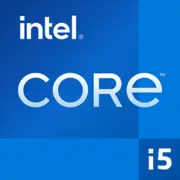Intel Core i5-13500H

Intel Core i5-13500H: A Balance of Power and Mobility in 2025
Modern laptops demand processors that offer not only high performance but also energy efficiency. The Intel Core i5-13500H, introduced within the Raptor Lake architecture, has become one of the most popular solutions for versatile devices. Let's break down what makes it stand out and who it is suitable for.
1. Architecture and Process Technology: A Hybrid Approach and New Technologies
The Intel Core i5-13500H is built on the hybrid Raptor Lake architecture, which combines two types of cores:
- Performance-cores (P-cores): 4 high-performance cores with Hyper-Threading support (a total of 8 threads). Base frequency — 2.6 GHz, maximum turbo mode — 4.7 GHz.
- Efficient-cores (E-cores): 8 energy-efficient cores (8 threads) with a base frequency of 1.9 GHz and turbo up to 3.5 GHz.
Total cores — 12, threads — 16, making the processor ideal for multitasking.
- Process Technology: Intel 7 (10nm Enhanced SuperFin). Improvements over Alder Lake include optimized power consumption and increased frequency stability under load.
- Cache: 18 MB of L3 cache speeds up data processing in resource-intensive applications.
- Integrated Graphics: Intel Iris Xe with 80 execution units and a frequency of up to 1450 MHz. Supports 4K displays, AV1 decoding, and light gaming (e.g., CS2 at medium settings delivers 40-50 FPS).
2. TDP of 45W: A Balance Between Power and Heat
A Thermal Design Power (TDP) of 45W indicates its belonging to the segment of high-performance mobile processors. This means:
- Powerful Laptops: Devices with this CPU typically feature cooling systems with dual fans and copper heat pipes.
- Operating Modes: In power-saving mode, TDP can drop to 35W; in turbo mode, it can temporarily reach 95W. However, without quality cooling, frequencies drop quickly.
- Practical Example: In the ASUS ZenBook Pro 14 (2025) with the i5-13500H, temperatures under load do not exceed 75°C, while in the compact HP Pavilion 15 (without advanced cooling), the processor throttles after just 10 minutes of rendering.
3. Performance: From Office Tasks to Gaming
Office Tasks:
- Simultaneous work with 30+ tabs in Chrome, Excel spreadsheets, and Zoom — CPU load does not exceed 30%.
- Running Word, Photoshop, and streaming video — instant switching between applications thanks to 16 threads.
Multimedia:
- Rendering a 10-minute video in Premiere Pro (1080p) takes ~8 minutes compared to ~12 minutes with the i5-12500H.
- Photo editing in Lightroom with AI filters — no lags even when working with RAW files.
Gaming:
- On integrated graphics: GTA V — 45-50 FPS (1080p, low settings), Fortnite — 60 FPS (720p, medium settings).
- With a discrete graphics card (e.g., NVIDIA RTX 4050): Cyberpunk 2077 — 60 FPS (1080p, medium settings with DLSS).
Turbo Boost Mode:
- In the Cinebench R23 benchmark, the single-threaded score is 1800 pts, while the multi-threaded score is 13500 pts. However, after 5 minutes of testing, performance drops by 12-15% due to overheating in thin laptops.
4. Use Cases: Who Should Consider the i5-13500H?
- Students and Office Workers: Multitasking + moderate laptop price (starting from $900).
- Creative Professionals: Suitable for video editing and 3D modeling (but for heavy projects, i7/Ryzen 7 is better).
- Gamers: Comfortable gaming in AAA titles when paired with a discrete GPU.
- Travelers: Laptops with this CPU weigh 1.8-2.2 kg, which is acceptable for frequent travel.
5. Battery Life: How Long Will the Battery Last?
- Energy-Saving Technologies:
- Intel Dynamic Tuning 3.0: Automatically reduces TDP when running on battery.
- Adaptix™ Technology: Optimizes core load in real-time.
- Battery Life Examples:
- Video playback (1080p, 50% brightness) — up to 8 hours (in a laptop with a 70 Wh battery).
- Office work + browser — 6-7 hours.
- Gaming (without being plugged in) — no more than 1.5 hours.
6. Comparison with Competitors
- AMD Ryzen 7 7735HS: 8 Zen 3+ cores, 35W TDP. Better in multi-threaded tasks (Cinebench R23 — 14500 pts), but weaker in single-threaded (1700 pts). Laptop prices are similar.
- Apple M3: More energy-efficient (18 hours of battery life in MacBook Pro), but limited compatibility with Windows applications.
- Intel Core i7-13700H: 15-20% more powerful in multi-threaded tests but more expensive ($1300+ vs. $900-$1100 for i5).
7. Advantages and Disadvantages
Pros:
- Ideal for versatile tasks.
- Supports DDR5-5600 and PCIe 5.0 (fast SSDs and external GPUs).
- Good integrated graphics.
Cons:
- Possible overheating in thin laptops.
- Average battery life under active use.
8. Recommendations for Choosing a Laptop
- Ultrabooks (e.g., Dell XPS 13): Lightweight (up to 1.3 kg) but may limit TDP to 35W.
- Gaming Models (MSI Katana 15): Powerful cooling, discrete graphics, but weight from 2.5 kg.
- Workstations (Lenovo ThinkPad P16s): High reliability, ECC memory support.
What to Consider:
- Cooling system: at least two fans.
- RAM: 16+ GB DDR5.
- Screen: For creative tasks — 100% sRGB, for gaming — 144 Hz.
9. Final Conclusion
The Intel Core i5-13500H is a smart choice for those seeking a balance between performance, price, and mobility. It is suitable for:
- Users needing a laptop "for all occasions."
- Gamers willing to compromise between weight and power.
- Professionals working with graphics and video on the go.
Key Benefits:
- Performance for most tasks without overpaying for top-end models.
- Modern technologies (PCIe 5.0, Thunderbolt 4).
- Affordable prices: Laptops with i5-13500H start at $900.
If you’re not ready to pay for a flagship i7 but want a device that won’t become obsolete in a year, the i5-13500H is one of the best options on the market for 2025.
Basic
CPU Specifications
Memory Specifications
GPU Specifications
Miscellaneous
Benchmarks
Compared to Other CPU
Related CPU Comparisons
Share in social media
Or Link To Us
<a href="https://cputronic.com/cpu/intel-core-i5-13500h" target="_blank">Intel Core i5-13500H</a>

